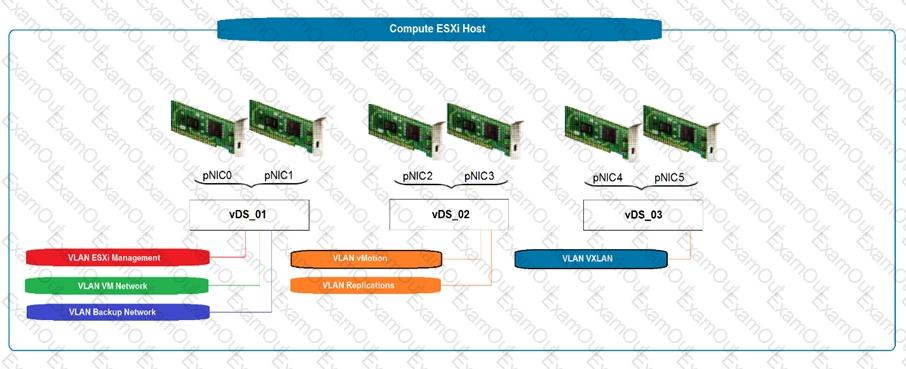An architect is designing a VMware solution for a customer to meet the following requirements:
The solution must use investments in existing storage array that supports both block and file storage.
The solution must support the ability to migrate workloads between hosts within a cluster.
The solution must support resource management priorities.
The solution must support the ability to connect virtual machines directly to LUNs.
The solution should use existing 32G fabric infrastructure.
There is no budget for additional physical hardware.
Which design decision should the architect make to meet these requirements?
An architect is designing a new backup solution for a vSphere platform that has been recently upgraded to vSphere 7.
The architect wants the backup solution to perform the following:
Full virtual machine image backup and restore
Incremental virtual machine image backup and restore
File level backup and restore within both Windows and Linux virtual machines
LAN-free backup
Which functional requirement should the architect include in the design of the new backup solution?
An architect is designing an environment for a retail customer. The design will use a single small vCenter Server Appliance and a cluster of eight ESXi hosts at a remote site. There is a single 10 GbE connected network at the remote site to support all management services. It is not possible to create additional management networks at the remote site. Virtual machine backups at the site will be dependent on the vCenter Server being available.
Which design decision should the architect make to maximize availability for backups?
An architect is designing a VMware software-defined data center (SDDC) solution based on the following customer requirements:
The solution must initially support 1,000 virtual machines
The solution must scale to support the concurrent running of up to 5,000 virtual machines
The production environment should be delivered across two data centers
The solution should have a maximum tolerable downtime (MTD) of four hours
The solution should have a monthly service availability target of 99.8%
Which two assumptions could the architect make based on the information from the customer to help size the solution? (Choose two.)
An architect is finalizing the design for a new vSphere platform based on the following information:
All Windows virtual machines will be hosted on a dedicated cluster for licensing purposes.
All Linux virtual machines will be hosted on a dedicated cluster for licensing purposes. All management virtual machines will be hosted on a dedicated cluster.
A total of ten physical sites will be used to host virtual machines.
In the event of one physical datacenter becoming unavailable, the manageability of the virtual infrastructure in the remaining data centers should not be impacted.
Access to configure the management virtual machines via vCenter Server must be controlled through the management Active Directory domain.
Access to configure the Windows and Linux virtual machines must be controlled through the resource Active Directory domain.
The management and resource Active Directory domains are part of separate Active Directory forests and do not have any trusts between them.
The design will use Active Directory with Integrated Windows Authentication.
How should the architect document the vCenter Server configuration for this design?
During a requirements gathering workshop, the customer provides the following requirement:
A new vSphere platform must be designed securely and all interfaces must be protected against potential snooping.
How should this non-functional security requirement be documented?
What is a benefit of using a scale-out method for handling vSphere cluster growth?
Refer to the exhibit.
During a requirements gathering workshop, the architect shares the following diagram:

What should the architect recommend for guaranteed throughput for each service?
During a requirements gathering workshop, the customer provides the following information:
Each host has 2 × 10 GbE NIC
EtherChannel is not currently configured
No changes can be made to the physical network
Network throughput must be prioritized for defined critical services
Which two recommendations should the architect make with regard to virtual networking? (Choose two.)
The Chief Operating Officer (COO) at an organization raises concerns that their virtual infrastructure environment is vulnerable. Recently, a security-related issue with a virtual machine caused all management services to become unavailable. No budget is available in the short term for additional platform investment. An architect is asked to review the current environment and make recommendations to mitigate concerns.
A virtualization administrator has provided the following details:
There is a single four node cluster of ESXi servers
There are two, Layer 2, physical network switches connecting resources
The data center network is presented as a single /16 subnet
Given the information provided, which functional requirement should the architect include in the design to mitigate the COOs concerns?

